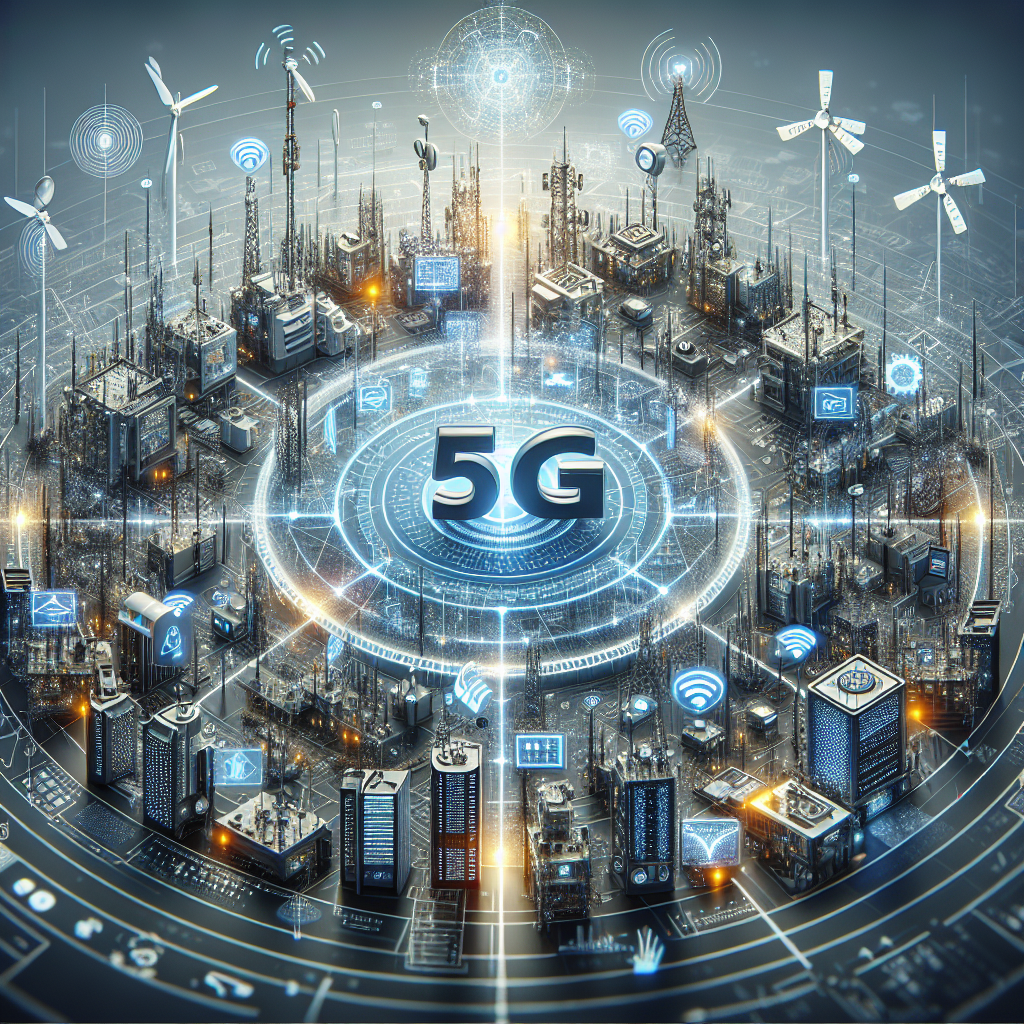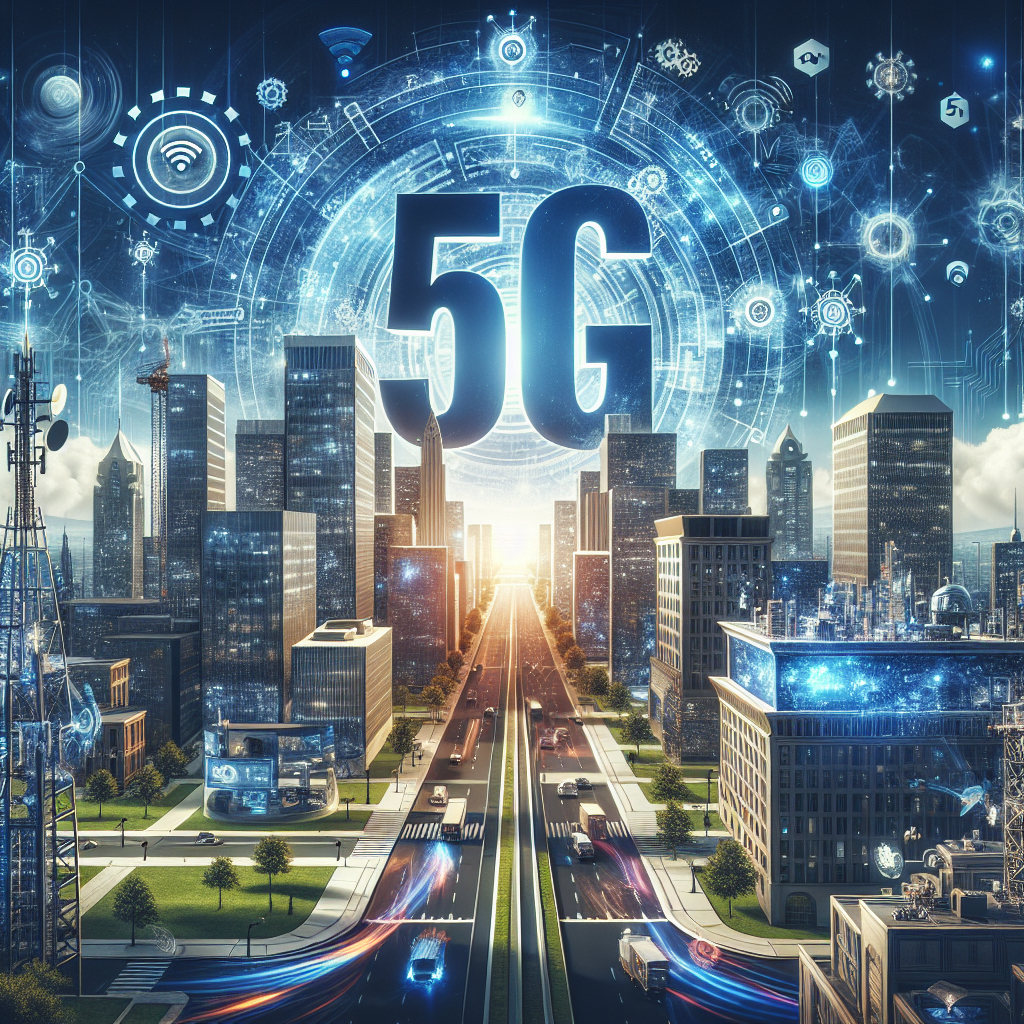In today’s digital age, the realm of government services is undergoing a revolutionary transformation with the advent of 5G technology. This cutting-edge development promises lightning-fast wireless internet, unparalleled data speeds, and groundbreaking possibilities for enhancing public services. The impact of 5G on government operations is immense, from streamlining communication and improving emergency response times to enabling smart cities and enhancing citizen engagement. Join us in this exploration of how 5G technology is reshaping the landscape of government services, revolutionizing the way in which citizens interact with their governing bodies, and paving the way for a more efficient and connected future.
Understanding 5G Technology

– Exploring the basics of 5G technology
5G technology, the fifth generation of wireless technology, represents a significant leap forward in communication capabilities. It promises faster speeds, lower latency, and increased network capacity compared to its predecessors.
- Differentiating 5G from previous generations of wireless technology
Unlike 4G LTE, which primarily focused on providing faster mobile internet speeds, 5G is designed to support a wide range of use cases beyond smartphones. It enables enhanced mobile broadband, ultra-reliable low-latency communication, and massive machine-type communication, making it a versatile technology for various applications. - Highlighting the key features and capabilities of 5G networks
Key features of 5G networks include higher data rates, improved reliability, lower latency, and increased network capacity. These features pave the way for transformative technologies such as Internet of Things (IoT), autonomous vehicles, smart cities, and virtual reality, revolutionizing how government services are delivered and accessed.

Integration of 5G in Government Services
Enhancing Communication Infrastructure
Incorporating 5G technology into government services plays a pivotal role in enhancing communication infrastructure. This advancement revolutionizes connectivity within government agencies, propelling them into a new era of efficiency and effectiveness. By leveraging 5G capabilities, agencies can establish robust networks that support high-speed data transfer and real-time communication. This facilitates seamless collaboration between departments, enabling swift information sharing and decision-making processes.
Furthermore, the integration of 5G technology empowers government services to overcome traditional communication barriers. With ultra-low latency and high bandwidth offered by 5G networks, agencies can streamline operations and optimize service delivery. This transformation in communication infrastructure not only improves internal coordination but also enhances the overall responsiveness and agility of government services in addressing citizen needs and concerns.
Boosting Public Safety and Emergency Services
In the realm of government services, the integration of 5G technology has revolutionized the landscape of public safety and emergency response capabilities. This cutting-edge technology enables authorities to leverage real-time data transmission during critical situations, thereby significantly enhancing the efficiency and effectiveness of emergency services.
- Real-time Data Transmission: One of the most notable impacts of 5G technology on government services is its ability to facilitate instantaneous data communication. During emergencies, this means that crucial information can be relayed swiftly and seamlessly between response teams, enabling them to make informed decisions promptly.
- Enhanced Response Times: With the high-speed connectivity offered by 5G networks, emergency responders can receive and transmit data rapidly, leading to a drastic reduction in response times. This accelerated communication process is pivotal in situations where every second counts, such as natural disasters or medical emergencies.
- Improved Coordination: The seamless connectivity provided by 5G technology also fosters enhanced coordination among various emergency response units. By enabling real-time sharing of information, agencies can collaborate more effectively, ensuring a cohesive and synchronized approach to managing crises.
- Optimized Resource Allocation: Furthermore, the integration of 5G in government services allows for better resource allocation during emergencies. Authorities can utilize real-time data insights to deploy personnel and equipment strategically, maximizing the impact of their response efforts and ultimately saving lives.
In essence, the incorporation of 5G technology in public safety and emergency services represents a paradigm shift in how governments can leverage advanced connectivity to safeguard their citizens and enhance overall disaster management capabilities.
Transforming Healthcare Services
Implementing telemedicine and remote patient monitoring with 5G
5G technology is revolutionizing healthcare services by enabling the widespread implementation of telemedicine and remote patient monitoring systems. Through the high-speed, low-latency capabilities of 5G networks, healthcare providers can conduct virtual consultations, monitor patients remotely in real-time, and even perform certain medical procedures through robotic assistance. This advancement in telemedicine not only improves the efficiency of healthcare delivery but also enhances patient access to medical expertise regardless of geographical barriers.
Improving access to healthcare in remote areas through advanced connectivity

One of the most significant impacts of integrating 5G technology into government healthcare services is the improved access to medical care in remote and underserved areas. By leveraging the enhanced connectivity provided by 5G networks, governments can establish telehealth centers and mobile clinics equipped with high-definition video conferencing capabilities and medical IoT devices. This ensures that individuals living in rural or isolated regions have access to healthcare professionals, diagnostic tools, and specialized treatments without the need to travel long distances to urban healthcare facilities.
Cybersecurity Challenges and Solutions
Addressing Data Privacy Concerns
In the realm of government services, the advent of 5G technology brings about a myriad of cybersecurity challenges that must be effectively tackled to ensure the protection of sensitive data. One of the paramount concerns revolves around data privacy and the need to uphold the confidentiality and integrity of government information transmitted over 5G networks. To address these data privacy concerns, several key strategies and solutions can be implemented:
- Ensuring secure transmission of sensitive government data over 5G networks: Government agencies must prioritize the establishment of robust security measures to guarantee the secure transmission of sensitive data over 5G networks. This entails implementing end-to-end encryption protocols and authentication mechanisms to prevent unauthorized access to confidential information.
- Implementing encryption protocols to safeguard information: Encryption serves as a critical tool in safeguarding government data from potential threats and breaches. By encrypting data both in transit and at rest, government entities can significantly enhance the security of their information and mitigate the risks associated with data interception or unauthorized access. Additionally, the deployment of secure communication channels and VPNs can further fortify the protection of data during transmission over 5G networks.
In essence, addressing data privacy concerns in the context of 5G technology requires a multi-faceted approach that encompasses encryption, authentication, and secure transmission protocols. By adopting these proactive measures, government agencies can bolster the resilience of their cybersecurity infrastructure and uphold the confidentiality of critical data in an increasingly interconnected digital landscape.
Mitigating Potential Cyber Threats
- Identifying vulnerabilities in 5G networks and government systems
- In the realm of 5G technology, the increased speed and connectivity also bring about new potential vulnerabilities that cyber attackers could exploit. It is essential for government entities to conduct thorough assessments to identify weak points in both their 5G networks and existing government systems. This proactive approach allows for targeted security measures to be implemented.
- Leveraging advanced technologies such as artificial intelligence and machine learning can aid in the identification of vulnerabilities at a faster pace and with greater accuracy. These technologies can analyze large datasets to detect anomalies and potential threats that may go unnoticed by traditional cybersecurity methods.
- Deploying robust cybersecurity measures to protect against cyber attacks
- Once vulnerabilities have been identified, it is crucial for government agencies to deploy robust cybersecurity measures to safeguard against potential cyber attacks. This includes implementing encryption protocols to secure data transmission over 5G networks, as well as establishing strict access controls to prevent unauthorized entry into government systems.
- Continuous monitoring and threat detection mechanisms are essential components of a comprehensive cybersecurity strategy. By actively monitoring network traffic and system activities, government entities can swiftly detect and respond to any suspicious behavior or attempted breaches. Additionally, regular security audits and penetration testing can help ensure that cybersecurity measures remain effective and up to date in the face of evolving cyber threats.
Policy and Regulatory Considerations
Establishing Frameworks for 5G Implementation
Developing regulations to govern the use of 5G technology in government services is a crucial step in maximizing the benefits of this advanced network infrastructure. The government must collaborate with industry experts to create comprehensive guidelines that ensure the efficient and secure deployment of 5G technology in various public services.
- Collaborative Approach: Government entities should work closely with telecommunications companies and technology providers to establish standards for implementing 5G in government operations. This collaboration is essential to address technical challenges and ensure interoperability across different systems.
- Security Protocols: One of the primary considerations in developing frameworks for 5G implementation is cybersecurity. The government must set stringent security protocols to safeguard sensitive data and ensure the integrity of government services running on 5G networks. Implementing encryption measures and access controls is critical to protecting against potential cyber threats.
- Spectrum Allocation: Effective utilization of spectrum resources is vital for the successful deployment of 5G technology. Governments need to allocate appropriate spectrum bands for 5G networks to support high-speed connectivity and low latency in delivering government services. Clear guidelines on spectrum allocation and management are essential for optimizing network performance.
- Quality of Service: Establishing frameworks for 5G implementation should also focus on ensuring the quality of service for government applications. Government agencies must define service level agreements (SLAs) with network providers to guarantee reliable connectivity and performance standards for critical services. Monitoring mechanisms should be in place to evaluate and maintain service quality over 5G networks.
- Compliance with Data Protection Laws: As government services involve handling sensitive citizen data, compliance with data protection laws and regulations is paramount. Frameworks for 5G implementation should incorporate measures to uphold privacy rights and data sovereignty. Implementing data protection impact assessments and transparency requirements can help ensure that government services on 5G networks adhere to legal standards.
In conclusion, establishing robust frameworks for 5G implementation in government services is essential to harness the full potential of this transformative technology. By addressing policy and regulatory considerations effectively, governments can leverage 5G networks to enhance service delivery, improve efficiency, and drive innovation in public administration.
Collaborating with Private Sector Partners
The successful integration of 5G technology into government services hinges on effective collaboration with private sector partners. This collaboration involves engaging with telecommunications companies to expand the 5G infrastructure and forming public-private partnerships to drive innovation in government services.
- Engaging with Telecommunications Companies
- Government entities need to work closely with telecommunications companies to ensure the widespread deployment of 5G networks. This collaboration is vital for establishing the necessary infrastructure to support the high-speed, low-latency connectivity that 5G offers.
- By partnering with telecom firms, governments can leverage their expertise in network deployment and management to accelerate the rollout of 5G technology. This collaboration also enables governments to tap into the latest advancements in telecommunications to optimize the delivery of public services.
- Forming Public-Private Partnerships
- Public-private partnerships play a crucial role in driving innovation in government services through 5G technology. These partnerships bring together the resources and capabilities of both sectors to co-create solutions that enhance service delivery and efficiency.
- By partnering with private sector firms, governments can access specialized knowledge and technologies that are essential for leveraging 5G in areas such as smart infrastructure, public safety, healthcare, and transportation. These collaborations foster a culture of innovation and enable governments to stay at the forefront of technological advancements.
Overcoming Financial and Technological Barriers
Allocating Budget for 5G Adoption
Investing in upgrading existing infrastructure to support 5G technology:
- Modernizing Communication Networks: Governments need to allocate funds towards upgrading their communication networks to be compatible with 5G technology. This involves enhancing the capacity and speed of existing infrastructure to handle the increased data traffic that comes with 5G.
- Implementing Network Security Measures: As governments transition to 5G, budget allocation is crucial for implementing robust security measures to protect sensitive data and ensure the integrity of government services. Investing in encryption technologies and cybersecurity protocols is essential to safeguard against potential threats in a 5G environment.
Identifying cost-effective solutions for deploying 5G in government services:
- Exploring Public-Private Partnerships: Governments can collaborate with private sector entities to share the financial burden of deploying 5G in government services. By leveraging the resources and expertise of private companies, governments can access cost-effective solutions for implementing 5G technology across various departments.
- Prioritizing Resource Allocation: Budget allocation for 5G adoption in government services should prioritize areas that will yield the highest impact and efficiency gains. By conducting thorough cost-benefit analyses, governments can identify the most cost-effective strategies for deploying 5G technology in critical government functions while optimizing resource allocation.
Building Technical Expertise
Government agencies are realizing the critical importance of equipping their personnel with the necessary skills to harness the full potential of 5G technology in delivering efficient and effective services to the public. This involves a concerted effort to provide comprehensive training programs and resources to enhance the technical expertise of government employees. Key strategies include:
- Training Programs: Implementing specialized training programs that focus on 5G technology and its specific applications in government services. These programs aim to deepen the understanding of how 5G can optimize processes, improve data transmission speeds, and enhance connectivity in various public sector domains.
- Skill Development: Emphasizing the development of skills such as network optimization, cybersecurity protocols, and data analytics within the context of 5G technology. By honing these competencies, government personnel can effectively navigate the complexities of integrating 5G into existing infrastructure and systems.
- Collaborative Learning: Encouraging collaborative learning environments where employees can exchange knowledge, share best practices, and collectively explore innovative ways to leverage 5G capabilities. This collaborative approach fosters a culture of continuous learning and adaptation to emerging technologies in the government sector.
- Innovation Culture: Cultivating an innovation culture that empowers government employees to think creatively and proactively about how 5G technology can revolutionize the delivery of public services. Encouraging experimentation and risk-taking within a supportive framework enables agencies to explore new possibilities and tailor 5G solutions to meet specific governance challenges.
By prioritizing the building of technical expertise among government personnel, agencies can position themselves to effectively navigate the transition to a 5G-powered ecosystem and unlock the transformative potential of this advanced technology in enhancing government services.
Future Prospects and Opportunities
In the realm of government services, the integration of 5G technology offers a myriad of future prospects and opportunities that have the potential to revolutionize the way public services are delivered and accessed. Here are some key aspects to consider:
Exploring the potential of 5G-enabled smart cities and governance
- Enhanced Connectivity: 5G technology’s ultra-fast speeds and low latency pave the way for seamless connectivity within smart cities, enabling real-time data sharing and communication between various municipal services and departments.
- IoT Integration: With the advent of 5G, the Internet of Things (IoT) can be leveraged more effectively in smart city infrastructure, allowing for interconnected systems that can optimize resource management, traffic flow, and public safety measures.
- Data Analytics: The high bandwidth and capacity of 5G networks enable governments to collect and analyze massive amounts of data generated by smart city sensors and devices, leading to more informed decision-making and targeted policy interventions.
Harnessing the benefits of 5G technology for sustainable development and citizen engagement
- Environmental Sustainability: By utilizing 5G-enabled technologies such as smart energy grids and waste management systems, governments can promote sustainable practices and reduce carbon footprints in urban areas.
- Citizen-Centric Services: 5G facilitates the delivery of personalized and interactive government services to citizens, enhancing overall satisfaction and engagement with public institutions.
- Remote Access: Through the deployment of 5G networks, remote and underserved communities can gain improved access to essential government services, bridging the digital divide and promoting inclusivity in service delivery.
In conclusion, the integration of 5G technology in government services holds immense promise for enhancing operational efficiency, promoting sustainability, and fostering greater citizen participation in governance processes.
FAQs: Unveiling the Impact of 5G Technology on Government Services
What is 5G technology and how does it differ from previous generations of mobile networks?
5G technology is the fifth generation of cellular network technology that offers faster speeds, higher capacity, lower latency, and improved reliability compared to previous generations such as 4G. This enables more connected devices, faster data transfer rates, and greater network efficiency.
How can 5G technology improve government services?
5G technology can enhance government services by enabling faster and more reliable communication between agencies, improving data collection and sharing, enabling the use of advanced technologies such as IoT and AI, and supporting the development of smart cities and public safety initiatives.
What are some potential use cases of 5G technology in government services?
Some potential use cases of 5G technology in government services include improving emergency response times, enhancing public transportation systems, enabling remote healthcare services, increasing efficiency in administrative tasks, and facilitating secure and reliable communication for government employees.
How can governments ensure the security and privacy of data when implementing 5G technology in government services?
Governments can ensure the security and privacy of data when implementing 5G technology in government services by implementing strong encryption protocols, adopting strict access controls, conducting regular security audits, collaborating with cybersecurity experts, and complying with data protection regulations.
What challenges may governments face when implementing 5G technology in government services?
Some challenges that governments may face when implementing 5G technology in government services include the high cost of infrastructure deployment, the need for skilled personnel to manage and maintain the technology, concerns about potential health risks from exposure to radiofrequency radiation, and the challenge of ensuring equitable access to 5G services for all citizens.


